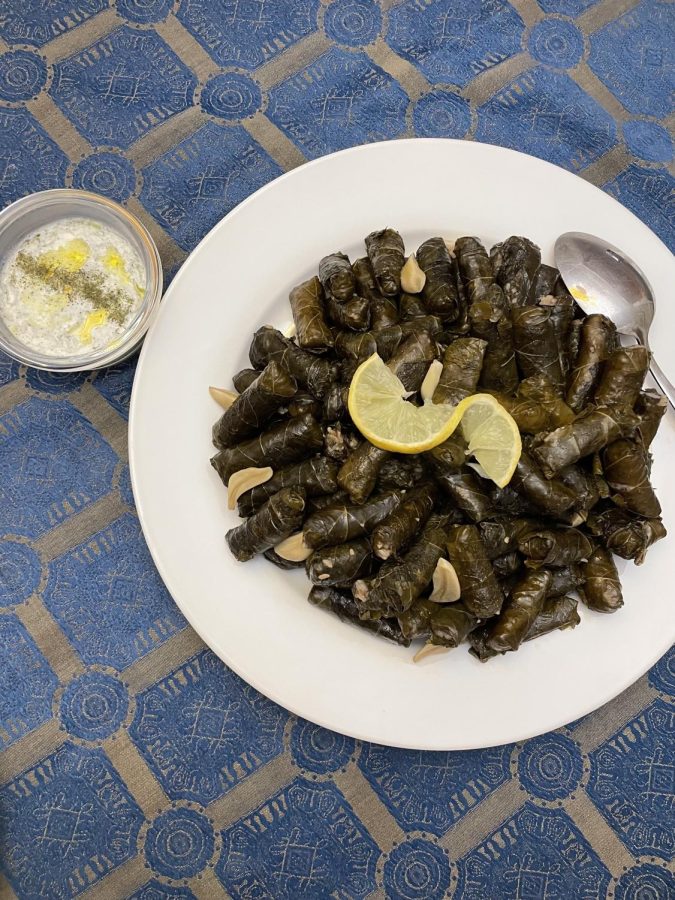Syrian Stuffed Grape Leaves (“Yabrak”)
Yabrak, the fruit of long labor, fills tummies and hearts across the world!
March 14, 2023
When we started what would be a two-hour-long leaf-rolling process, we (over) confidently started rolling the first yabrak, only to find that the process was more complicated than we originally thought. We began to understand why yabrak rolling was considered a rite of passage. In Syria, among other countries in the Middle East, Mediterranean, and the Caucasus, the long laborious process is seen as a testament of love, patience, and care. In fact, UNESCO recognized “dolma”-making (an almost identical dish) in Azerbaijan as an integral food preparation practice, adding it to their Representative List of the Intangible Cultural Heritage of Humanity.
In certain countries, pomegranate molasses, tomatoes, and fresh herbs like parsley are added to the filling. In Palestine and Jordan, the same filling is used to make stuffed zucchini and tomatoes (“mahshi”), in addition to yabrak. In Iraq, the popular dish “dolma” combines all three. Whether you call them dolma, mahshi, warak dawali, yabrak, or even something else, this dish’s simple ingredients, laborious process, and undeniable delectability is the perfect way to show appreciation for your loved ones.
INGREDIENTS:
For stuffing:
16 oz. jar of grape leaves
½ lb of ~95% lean ground beef
1¼ cups calrose (or short grain) rice
1 tsp allspice
¼ tsp cinnamon
½ tsp ground pepper
Salt to taste
¼ cup water (or as needed)
Vegetable oil as needed
For cooking:
8 whole garlic cloves peeled
½ cup lemon juice (4-5 lemons)
1 or 2 potatoes
¼ oil
Enough water to cover the yabrak
Salt to taste
INSTRUCTIONS:
1. First, make the filling by mixing the beef, rice, spices, oil, and water until the consistency is smooth and paste-like.
2. To prepare the grape leaves, drain the salt water from the jar. Rinse the leaves in cold water to remove the salt and pat dry with paper towels.
3. Remove the stem and place the leaf stem side up. Then, place a small spoonful of filling at the base of the leaf, and be careful not to overfill the leaves or rip them. Fold the sides inwards and roll the grape leaf, tucking in the sides as you go. Repeat the process for the remaining leaves. (Tip: Set up a workstation by having the leaves on one side, the stuffing on the other, the rolling station in the middle, and place the rolled leaves on a separate plate in front of you. Add water occasionally when the filling dries up.)
4. Once finished, cut the potatoes into thin, round slices to line the bottom of the pot. Arrange the yabrak in a circular pattern pointing towards the middle with the end pieces down to prevent opening. In between each layer, cut peeled garlic cloves and distribute evenly across the arrangement, placing them in any open crevices. After covering in water, oil, salt, and lemon, put a weight (or a plate with a bowl of water) on top of the arrangement.
5. To cook, put on medium heat until boiling, then lower to medium-low for about an hour (or 20 minutes if using a pressure cooker) until the rice is cooked and leaves are tender.
6. When done cooking, drain the juice, and serve with “Laban bi Khyar” (yogurt with cucumber, garlic, lemon, and dried mint). Enjoy!
This recipe also appears in our February 2023 print edition.











